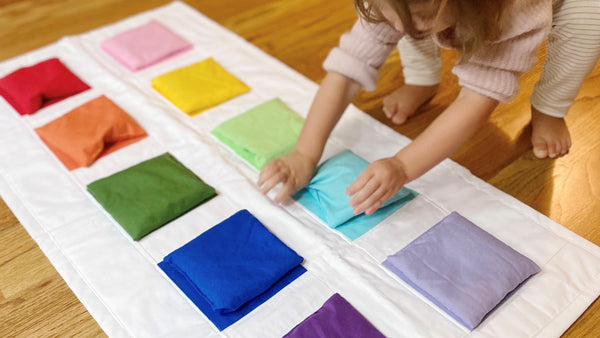As a mother and teacher of children with atypical brains, I was so grateful when we began to learn about sensory play. There was very little information available when we first started our journey of learning about our children's different brains and needs. The least I can do is share the things that have helped us.
Please remember - most, if not all, of these things can be done with simple items in your home or backyard. All it takes is a little research, planning, and persistence. That last one is key - persistence. We are in a marathon, friends, not a sprint. Our children may resist, may not progress as we hoped, may develop new symptoms, and we may get weary. Hang in there! If you haven't already figured it out, our little people are so strong, resilient, and awe-inspiring.
I hope you find some encouragement and helpful tips here. I'm cheering for you!

We know Sensory play is fun and beneficial for all children. But Sensory play for Neurodivergent children is a necessity. Autism, ADHD, Dyslexia, and Dyspraxia are all part of the spectrum of neurodivergent conditions. The neurodivergent brain has an especially difficult time processing sensory input.
Neurodivergent Children often experience sensory processing challenges. The brain is either over or under-stimulated by specific sensory input. These challenges don't affect every child the same way. Some may be sensitive to touch and sound and others to tastes and textures.
-
Sensory Seekers (Hyposensitivity) have certain senses that are dulled and seek out input that stimulates these senses.
-
Sensory Avoiders or (Hypersensitivity) have certain senses that are heightened and avoid input because it can be very unpleasant and overstimulating.
Knowing your child’s needs is essential for enjoyable sensory play. If you work with a therapist, you can ask for suggestions that would benefit your child. Your therapist can help you plan for a daily sensory diet ... breaks throughout the day to stimulate certain senses or calm an overstimulated child.
Beneficial sensory play with Different Seekers and Avoiders:

Tactile (Touch) Sensitivity:
Sensory Seeker - This child has under-stimulated sense of touch. Some characteristics of this child might be touching everything even when not consciously aware he is doing so, picking and poking at things, pinching or squeezing people or things too hard.- Sensory Play - things like play dough, clay, stress balls, sensory bins with different textures and temperatures, water, slime, and digging in dirt are great ways to meet your child’s need for touch.
Sensory Avoider - This child has an overstimulated sense of touch. Some characteristics of the child would be avoiding touch from others, avoiding certain textures and clothing, having issues wearing socks, and having difficulty with shoes.
- Sensory Play - Try dry, smooth textures like beans. Avoid wet, grainy, slimy textures at first. Pay attention to your child’s cues. Five minutes of touch is beneficial and will grow with more exposure. Trying new things is more manageable when introduced in a fun and playful way without pressure.

Visual Sensitivity
Sensory Seeker - This child may have difficulty seeing differences in puzzles, pictures, or objects. May have trouble locating a specific item when mixed in with other things, such as a food pantry, a desk full of supplies, clothes in a drawer, etc. They may have difficulties with depth perception and visually attending to items when all the colors and textures are the same.
- Sensory Play - colorful sensory bins, moving sensory bottles, spinning things, pinwheels, light tables, sun catchers, sparkly play, seek and find are great ways to stimulate the visual sense.
Sensory Avoider - This child may have sensitivity to bright lights, like to play in darker areas, avoid eye contact, and be easily distracted by slight movements and sounds ... clock ticking, movement outside of a window, people moving)
- Sensory Play - neutral colors, dimly lit rooms, slow-moving sensory bottles, and soft illustrations are best for sensory play.

Sound Sensitivity
Sensory Seeker - This child might turn the volume all the way up on music, tv, or tablet. He might need verbal directions repeated multiple times, enjoys making sounds, and might not respond to his own name being called.
- Sensory Play - shakers, musical instruments, sensory bins with beans or bells, headphones with music or music players, clickers, and keyboards are enjoyable for sensory input
Sensory Avoider - This child reacts strongly to loud or jarring sounds. She may hold her hands over her ears to protect herself from sounds, become anxious in noisy, busy places, and be unable to focus on background noise.
- Sensory Play - noise-canceling headphones, white noise, or brown noise tracks during sensory play; playing alone in a quiet corner can make other sensory inputs very enjoyable. Knowing and paying attention to your child's cues is very important.

Taste Sensitivity
Sensory Seeker - This child may put non-food items in their mouth, put too much food in their mouth or not chew food thoroughly. He might make mouth noises such as clicking, buzzing, or humming. This child may also bite.- Sensory Play - taste-safe sensory play with crunchy, salty, sweet, sour, cold, or hot sensory bases will help stimulate oral senses. Provide chewable toys, vibrating toothbrushes, and things allowed in the mouth to meet your child’s needs.
Sensory Avoider - This child is usually considered a picky eater, generally having a minimal diet with very few foods. Children don't just dislike these foods but can actually choke or gag on them, causing issues with eating and oral hygiene.
- Sensory Play - integrating different taste-safe sensory play can make trying new things a fun experience. Messy play with food can be an uninhibited approach to new tastes. Do not introduce sensory play as food to try but as play. The taste will happen naturally, but it may take a little while
Smell Sensitivity
Sensory Seeker - This child may not notice strong smells like others; they may crave certain smells and constantly smell things like toys or nonfood items. This child might also enjoy the smell of noxious odors - like sharpies, superglue, bleach, or gasoline.
- Sensory Play - scented sensory play with fresh or dried flowers, scent Jars, scented sensory bins, scratch and sniff books or stickers, and scented play dough, are great ways to experience smells.
Sensory Avoider - This child has a stronger than usual sense of smell. He may notice smells that no one else does and be distracted by smells. Scents that don't bother you can cause headaches, nausea, and avoidance to this child.
- Sensory Play - avoid strong smells, more than one at a time; try one gentle scent at a time. Most natural scents will be more tolerable in small doses. Don't minimize or brush off headaches and discomfort because you cannot smell the smell. Make sure that scents are contained and do not linger for a long time.

Vestibular (movement) Sensitivity
Sensory Seeker - This child seeks out a movement-intense activity such as bouncing, swinging, jumping, and spinning. He seems never to get dizzy, be reckless and thrill-seeking, and does not tire quickly. This child has poor muscle tone, poor balance, and inadequate body awareness.
- Sensory Play - swings, spinning seats, rocking chairs, bicycles, standing rather than sitting to play, and obstacle courses are beneficial ways to stimulate the vestibular senses.
Sensory Avoider - This child avoids most playground equipment, does not like to spin or swing, and is content to sit still. She will avoid anything to do with balance... it may cause fear or seem impossible.
- Sensory Play - Walking a tape line on the floor rather than a balance beam can help balance. Using the other senses while engaged in vestibular activities can help the brain process overstimulation. Try some things above but be aware of your child’s cues. Do things slowly and avoid things that cause stress.

Proprioception (body position) Sensitivity
Sensory Seeker - This child will like to play rough but does not know his own strength. He wants to walk heavily, stomp, or jump. They may write too hard, clap or drum on things often, throw themselves on the floor, and like to squeeze and grab items.
- Sensory Play - standing at a low table to smash and press play dough, carrying heavy things, crawling, pushing the shopping cart, tight hugs, trampolines, and bubbles are great for this sensory seeker.
Sensory Avoider - This child feels disoriented after spinning, jumping, or running. She often expresses fear and anxiety about having her feet leave the ground. They avoid tight clothing and people being too close. This child has difficulty manipulating small objects and mastering fine motor skills.
- Sensory Play - tools for sensory play can help with fine motor skills. Calming corners and beanbag chairs on the floor can be comforting. Integrating some of the above can regulate sensitivities but always be aware of your child’s cues.
Using the senses during play actually creates new nerve pathways through positive experiences. Sensory play is fun! Utilizing different experiences during play gives the child control over unpleasant stimuli and helps their brain learn to regulate responses. Under-stimulated children can learn helpful ways to meet these needs and retrain the brain.
Using multiple senses increases communication, memory, and self-regulation skills. You can use your child’s interests and sensory needs to implement daily sensory play, a positive experience for beneficial improvement in these areas.


